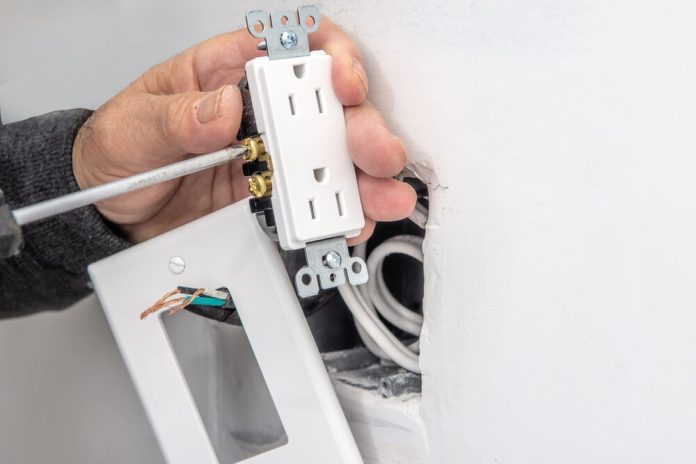In older homes—especially those built before the 1960s—you’ll often find 2-prong electrical outlets, also known as ungrounded outlets. These outlets have only two slots: one for the “hot” wire and one for the “neutral” wire. They were common when most household electrical devices had metal housings and internal insulation provided basic protection. However, they lack a grounding path, which is a vital safety feature in modern electrical systems. Without a ground wire, there’s no direct route for stray electrical current to safely dissipate into the earth in the event of a short circuit or fault. This can increase the risk of electrical shocks, appliance damage, or even fires. You should speak with an Electrician In Dripping Springs TX if you have 2 prong electrical outlets.
By contrast, 3-prong electrical outlets—the modern standard—include a third hole for the ground wire, which greatly improves electrical safety. The third prong connects to the home’s grounding system, which provides a low-resistance path for fault current to travel safely into the ground. This feature protects people from electric shock, prevents damage to sensitive electronics, and helps stabilize voltage levels in your home’s wiring system. In renovations, replacing 2-prong outlets with properly grounded 3-prong outlets is strongly recommended, especially in areas like Dripping Springs, Texas, where homes often undergo electrical upgrades during remodeling.
There are several types of 3-prong electrical outlets available today, each designed for different functions and safety needs:
- Standard Duplex Outlets– These are the most common type found in living rooms, bedrooms, and general-purpose areas. They have two plug-in slots and a grounding hole, supporting everyday devices like lamps, TVs, and small appliances.
- Tamper-Resistant (TR) Outlets– Now required by modern electrical codes in most areas, including Texas. They include built-in shutters that prevent children from inserting objects into the slots, reducing the risk of electrical shock.
- Ground Fault Circuit Interrupter (GFCI) Outlets– Essential for areas where moisture is present, such as bathrooms, kitchens, laundry rooms, garages, and outdoor locations. GFCIs monitor the flow of electricity between the hot and neutral wires and instantly cut off power if an imbalance (even as small as a few milliamps) is detected—helping prevent potentially fatal electric shocks.
- Arc Fault Circuit Interrupter (AFCI) Outlets– These detect dangerous electrical arcs caused by damaged wiring, loose connections, or frayed cords, which can lead to fires. AFCIs are typically installed in bedrooms and living areas per modern building codes.
- Weather-Resistant (WR) Outlets– Designed for exterior use, these outlets are made with durable, corrosion-resistant materials and often paired with protective covers to withstand humidity, rain, and sun exposure.
- Combination Outlets– These integrate multiple functions into a single device, such as GFCI/AFCI protection or USB charging ports along with standard plug receptacles. They’re especially useful in kitchens, home offices, and entertainment areas.
When renovating your home in Dripping Springs, upgrading from 2-prong to grounded 3-prong outlets not only brings your home up to current National Electrical Code (NEC) standards but also enhances safety and compatibility with modern electronics. However, this upgrade often requires adding or confirming the presence of a proper grounding conductor or using approved GFCI outlets labeled “No Equipment Ground” if rewiring isn’t immediately possible.
In short, 2-prong outlets represent outdated, ungrounded systems, while 3-prong outlets provide modern protection, reliability, and compliance with safety codes—a crucial improvement when modernizing or selling your home.
It’s understandable to think installing electrical outlets looks simple—after all, it often just involves connecting a few wires. However, whether you should do it yourself or hire a licensed electrician in Dripping Springs, Texas depends on several important safety, legal, and technical factors.
Here’s a breakdown to help you decide:
⚡ Why Installing Outlets Isn’t Always as Simple as It Looks
Even though replacing an outlet may seem straightforward, several hidden issues can make it more complicated and potentially dangerous:
- Grounding Requirements:
Older homes in Dripping Springs (and much of Central Texas) often still have 2-wire systems without a dedicated ground wire. Installing a modern 3-prong outlet on an ungrounded circuit without the proper modifications can create a false sense of safety—the outlet might look grounded, but it won’t actually protect against faults. - Circuit Compatibility and Load:
It’s critical to ensure the circuit can handle the electrical load and that the outlet’s amperage rating matches the circuit (for example, 15-amp vs. 20-amp circuits). Installing the wrong type can overheat wires or damage appliances. - Code Compliance:
Texas electrical work must meet the National Electrical Code (NEC)and local Dripping Springs building regulations. A licensed electrician in Dripping Springs TX knows the latest code updates, including placement requirements (like GFCI in wet areas, AFCI in bedrooms, and tamper-resistant outlets throughout the home). - Safety Risks:
Incorrect wiring—even one loose or reversed connection—can cause electrical shocks, fires, or damage to connected devices.
For example:
- Reversing “hot” and “neutral” wires can make metal parts of plugged-in devices live.
- Missing a secure ground can cause appliances to short out or shock users.
- Inspection and Insurance Implications:
If you plan to sell or insure your home, any DIY electrical work that’s not performed or signed off by a licensed electrician in Dripping Spring TX could fail inspection or void parts of your home insurance coverage.
- Inspection and Insurance Implications:
🧰 When a Homeowner Might DIY
If you’re simply replacing an existing, grounded 3-prong outlet (same type, same location, same wiring) and you’ve turned off the breaker, verified no power with a tester, and understand basic wiring color codes, this can sometimes be a safe DIY project.
However, if you’re adding new outlets, upgrading ungrounded ones, or installing GFCI/AFCI outlets, it’s best to leave that to a pro.
👷 Why Hiring a Licensed Electrician In Dripping Springs TX Is the Safer and Smarter Choice
A licensed electrician in the Dripping Springs area can:
- Inspect your home’s electrical system for proper grounding and code compliance.
- Safely install and test GFCI, AFCI, or tamper-resistant outlets.
- Replace ungrounded 2-prong outlets with code-approved options (either grounded or GFCI-labeled “no equipment ground”).
- Ensure proper load balancing across circuits to prevent tripped breakers or overheated wiring.
- Provide documentation that may be important for insurance or future home sales.
You can typically expect a local electrician in Dripping Springs TX to charge around $100–$200 per outlet for installation or replacement (including parts and labor), depending on complexity. The peace of mind and long-term safety benefits are well worth the cost.
✅ Bottom Line
If it’s a simple like-for-like outlet replacement and you’re confident in your knowledge, you might do it yourself—after turning off power and double-checking wiring with a tester.
But if you’re upgrading from 2-prong to 3-prong outlets, installing GFCIs, or adding new circuits, always hire a licensed electrician in Dripping Springs. It ensures your home is safe, compliant with Texas codes, and fully protected from electrical hazards.
Would you like me to recommend what questions to ask when hiring an electrician in the Dripping Springs area to make sure you get a qualified one?











